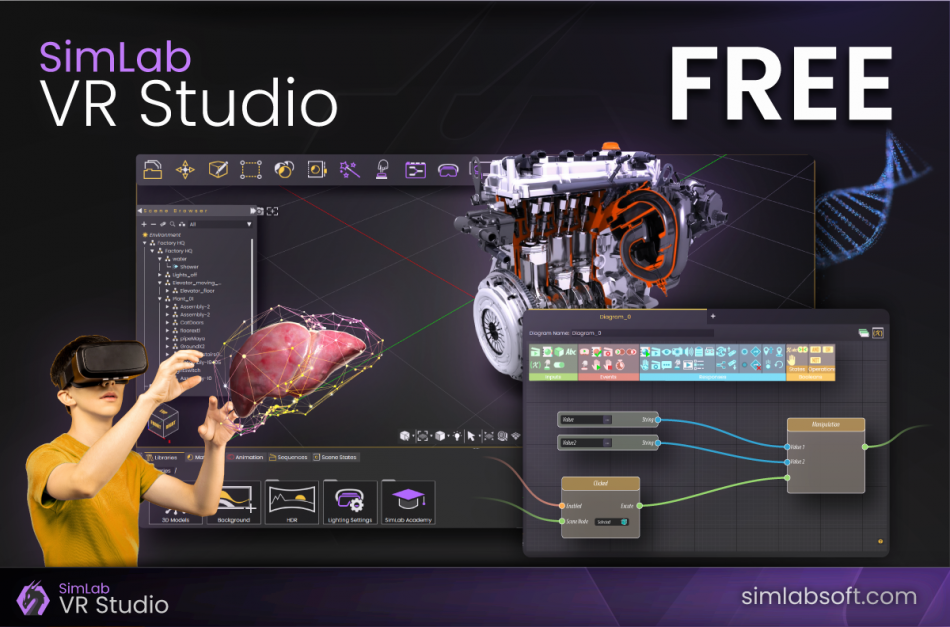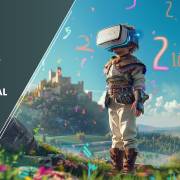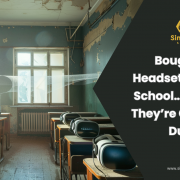Schools are always looking for new and innovative ways to teach their students. With technology becoming more and more commonplace in our lives, it makes sense for schools to start using virtual reality as a teaching tool. VR is an immersive experience that can allow students to learn in a whole new way. In this blog post, we will show you how easy it is to get started with VR in the classroom!
What Is VR?
Before we get started, let’s first answer the question: what is VR? VR stands for virtual reality. Virtual reality is a computer-generated simulated environment that you can interact with using a headset. When you put on a VR headset, you are transported into this alternate world where you can explore and interact with your surroundings.
Why Use VR in the Classroom?
There are many reasons why you would want to use VR in the classroom. Some of the benefits of VR include:
1. Allowing students to experience things
The first and most obvious reason to use VR in the classroom is that it allows students to experience things that they otherwise would not be able to. For example, if you are teaching a history class, you can transport your students back in time and have them experience history firsthand. This is an incredibly powerful way to learn and will help your students retain information better.
2. Engaging students in learning
Another reason to use VR in the classroom is that it can help engage students in their learning. Many students today have short attention spans and are easily distracted. VR can help keep them focused and engaged in what they are learning. When students are fully immersed in a VR experience, they are less likely to be distracted by things going on around them.
3. Making difficult concepts easier to understand
Another benefit of VR is that it can make difficult concepts easier to understand. For example, if you are teaching a science class, you can use VR to help your students visualize complex concepts. This can be especially helpful for visual learners.
4. Helping students with special needs
VR can also be used to help students with special needs. For example, if you have a student who is scared of heights, you can use VR to help them overcome their fear in a safe and controlled environment.
5. Allowing students to practice skills
VR can also be used to allow students to practice skills. For example, if you are teaching a nursing class, you can use VR to allow your students to practice things like IV insertion in a safe and controlled environment. This is a great way for students to get hands-on experience without having to worry about the consequences of making mistakes.
6. Preparing students for real-world scenarios
VR can also be used to prepare students for real-world scenarios. For example, if you are teaching a fire safety class, you can use VR to put your students in a simulated fire. This will allow them to experience what it is like to be in a fire and help them better understand how to react in a real-world situation.
7. Encouraging teamwork
Finally, VR can be used to encourage teamwork. When students are working together in a VR environment, they have to communicate and cooperate with each other to complete the task at hand. This is a great way to teach students the importance of teamwork and communication.
Applications of VR in Classroom
Now that we’ve talked about some of the benefits of VR let’s talk about some specific ways that you can use VR in the classroom.
1. Field trips
One way to use VR in the classroom is to take your students on virtual field trips. There are a number of different apps that you can use to do this. Google Expeditions is one of the most popular options. With Google Expeditions, you can take your students on virtual field trips to a number of different places, including the Great Barrier Reef, Machu Picchu, and the American Museum of Natural History.
2. Simulations
Another way to use VR in the classroom is to create simulations. Simulations can be used to teach a variety of different subjects, including science, math, and social studies. There are a number of different apps that you can use to create simulations. one of the most popular options is CoSpaces Edu. With CoSpaces Edu, you can create a variety of different simulations, including an erupting volcano, a roller coaster, and a solar system.
3. Virtual reality experiences
Another way to use VR in the classroom is to create virtual reality experiences for your students. There are a number of different apps that you can use to do this. Google Earth VR is one of the most popular options. With Google Earth VR, you can take your students on virtual reality tours of a number of different places, including the Eiffel Tower, the Statue of Liberty, and Niagara Falls.
4. Games
Finally, another way to use VR in the classroom is to use games. Games can be used to teach a variety of different subjects, including science, math, and social studies. There are a number of different apps that you can use to create games. one of the most popular options is QuiverVision. With QuiverVision, you can create a variety of different games, including an erupting volcano, a roller coaster, and a solar system.
How to Use VR in the Classroom
Now that we’ve talked about some of the benefits of VR let’s talk about how you can actually use VR in the classroom.
1. Purpose
The first step is to determine the purpose of using VR in the classroom. What do you want your students to learn? How will VR help them learn it?
2. Platform
The next step is to choose a platform. There are a number of different platforms that you can use, including Google Expeditions, CoSpaces Edu, and QuiverVision.
3. Activity
Once you’ve chosen a platform, the next step is to choose an activity. There are a number of different activities that you can do, including taking virtual field trips, creating simulations, and playing games.
4. Implementation
Finally, once you’ve chosen an activity, the next step is to implement it in the classroom. How will you use VR in the classroom? Will you use it during a lesson? Will you use it for an assessment?
These are just a few ideas of how you can use VR in the classroom. There are a number of different ways to use VR, and the possibilities are endless.
How to Create Custom VR Software for Students?
Creating custom VR software for students can be a daunting task, but it’s not impossible. You can use different VR studies that help to create software for the VR experience quite easily. Even teachers are able to use such software without any technical skills like coding.
For example, SimLab Soft is a 3D software development company that provides VR creation software for students and educators. With SimLab VR Studio, you can create a variety of different VR experiences, including an erupting volcano, a roller coaster, and a solar system.
Why Choose SimLab for Creating Custom VR Software for Students?
SimLab is a great option for creating custom VR software for students because it’s easy to use and it’s affordable, actually Free edition is enough for most cases.
Some of the key features that make SimLab a great option for creating custom VR software for students include:
- All creation tools: SimLab provides a variety of different creation tools that you can use to create VR experiences for your students.
- Free edition: SimLab provides free edition ready to be used by students and teachers.
- Unlimited VR viewers: SimLab allows you to create unlimited VR experiences for your students.
- Quizzes: SimLab allows you to create quizzes for your VR experiences.
- Surveys: SimLab allows you to create surveys for your VR experiences.
- User-defined tracking: SimLab allows you to track how your students are using your VR experiences.
What can you do with SimLab VR Studio?
With SimLab, possibilities are endless! The tool allows you a number of different ways to use VR in the classroom. For example:
1. VR Creation: Interactive VR Creation (No Coding)
SimLab makes it possible for you to create interactive VR experiences without any coding! This is perfect for those who want to create VR content but don’t have the coding skills. All you need is a computer and SimLab VR Studio.
2. VR Training: Advanced VR for training and education
SimLab VR Studio is perfect for creating advanced VR experiences for training and education. It allows you to create realistic simulations that can be used to train people in a variety of different fields.
3. VR Evaluation: Utilize Quizzes/Surveys to measure user performance
SimLab VR Studio allows you to create quizzes and surveys that can be used to evaluate a user’s performance in a VR experience. This is perfect for those who want to use VR to assess a student’s understanding of content or skills.
4. VR Viewing: Free viewing of VR experiences on all devices
SimLab VR Studio also allows you to create VR experiences that can be viewed on a variety of different devices. This includes Oculus Rift, HTC Vive, Pico, Quest, and Google Cardboard. You can also view your VR experiences on your computer or mobile device. This makes it possible for you to share your VR experiences with a wide audience.
SimLab VR Studio is the perfect tool for those who want to use VR in the classroom. It is easy to use and allows you to create a variety of different VR experiences. If you are looking for a way to use VR in your classroom, SimLab VR Studio is the perfect solution!
Conclusion
VR for students is a new tutorial teaching VR in schools which is created by using SimLab. It is easy to use and provides free updates. You can also create unlimited VR experiences and export them to more than 20 file formats.
SimLab also allows you to create quizzes surveys and track how your students are using your VR experiences. If you want to use VR in the classroom, SimLab VR Studio is the perfect solution!
FAQs
How can VR be used in the classroom?
There are a number of different ways that VR can be used in the classroom. VR can be used to create simulations for training and education, to assess student understanding through quizzes and surveys, or to simply view VR experiences on a variety of devices.
Can you do school on VR?
With SimLab VR Studio, you can create VR experiences for training and education. You can also create quizzes and surveys to assess student understanding.
Which VR is best for education?
SimLab VR Studio is the perfect tool for those who want to use VR in the classroom. It is easy to use and allows you to create a variety of different VR experiences.
How can VR help teachers?
VR can help teachers by providing a new way to teach and assess student understanding. VR can also be used to create simulations for training and education.



